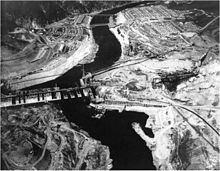Low dam
On July
16, 1933, a crowd of 3,000 watched the driving of the first stake at
the low dam site, and excavation soon began. Core drilling commenced
that September while the Bureau of Reclamation accelerated its studies
and designs for the dam.
[22]
It would still help control floods and provide for irrigation and
hydroelectricity, though at a reduced capacity. Most importantly, it
would not raise its reservoir high enough to irrigate the plateau around
the Grand Coulee. However, the dam's design provided for future raising
and upgrading.
[18]
The east-side
cofferdam after the west base was complete
Before and during construction, workers and engineers experienced
problems. Contracts for companies to construct the various parts of the
dam were difficult to award as few companies were sizable enough to fill
them. This forced companies to consolidate. In addition, Native
American graves had to be relocated and temporary
fish ladders
had to be constructed. During construction additional problems included
landslides and the need to protect newly poured concrete from freezing.
[17] Construction on the downstream
Grand Coulee Bridge began in
May 1934
and more considerable earth-moving began in August. Excavation for the
dam's foundation required the removal of 22,000,000 cu yd (17,000,000 m
3) of dirt and stone.
[23] To reduce the amount of trucking required in the excavation, a
conveyor belt nearly 2 mi (3.2 km) long was built.
[24]
To further secure the foundation, workers drilled 660–880 ft
(200–270 m) holes into the granite and filled any fissures with grout,
creating a
grout curtain.
[25]
At times, excavated areas collapsed from overburden. In order to secure
these areas from further movement and continue excavation, 3-inch
(76 mm) diameter pipes were inserted into the mass and chilled with cold
liquid from a refrigeration plant. This froze the earth and secured it
so construction could continue.
[26]
Final contract bidding for the dam began
June 18, 1934, in Spokane, and four bids were submitted. One bid was from a lawyer with no financial backing; another was from actress
Mae West which consisted of nothing more than a poem and promise to divert the river.
[27]
Of the two serious bids, the lowest bid was from a consortium of three
companies: Silas Mason Co. from Louisville, Kentucky, Walsh Construction
Co. of
Davenport, Iowa and New York and Atkinson-Kier Company of
San Francisco and
San Diego. The consortium was known as MWAK and their bid was $29,339,301, almost 15% lower than the
$34.5 million option submitted by the next bidder,
Six Companies, Inc., which was building
Hoover Dam at the time.
[28]
Cofferdams
Two large
cofferdams
were constructed for the dam, but they were parallel to the river
rather than straddling its width, so drilling into the canyon walls was
not required. By the end of 1935 about 1,200 workers completed the west
and east cofferdams. The west cofferdam was 2,000 ft (610 m) long, 50 ft
(15 m) thick and was constructed 110 ft (34 m) above the bedrock.
[29]
The cofferdams allowed workers to dry portions of the riverbed and
begin constructing the dam, while water continued to flow down the
center of the riverbed.
[30] In
August 1936,
once the west foundation was complete, portions of the west cofferdam
were dismantled, allowing water to flow through part of the dam's new
foundation. In
February 1936, MWAK had begun
constructing cofferdams above and below the channel between the east
and west cofferdams. By December, the entire Columbia River was diverted
over the foundations constructed within the east and west cofferdams.
On
December 15, 1936, the
Wenatchee Daily World announced that the river was diverted and by early the next year, people were arriving in large numbers to see the riverbed.
[31]

No comments:
Post a Comment